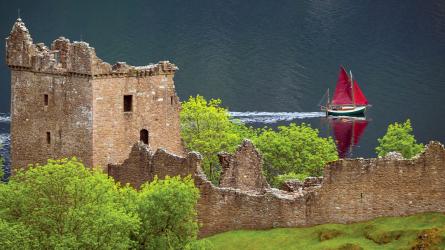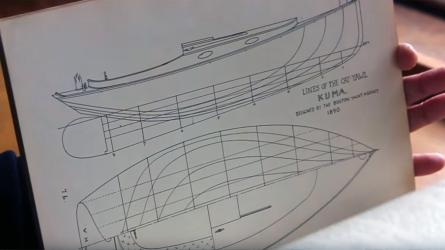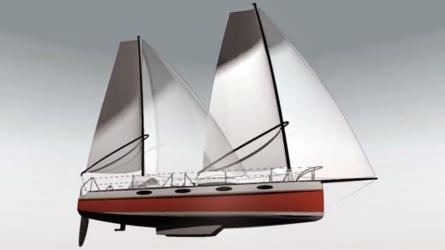Gold Cup Redux
Vintage powerboats gather on Lake George, New York
Vintage powerboats gather on Lake George, New York

LULU, a 22′ GarWood Speedster launched by Gar Wood Custom Boats (GWCB) in 2004, makes an early-morning run on Lake George. The photograph was taken from a 28′ Custom Runabout—a 1937 stock Gar Wood design built in 2010 by GWCB.
The Gold Cup—the oldest trophy in motorsports racing—was first contested in 1904 on the Hudson River, where the winner averaged just a little over 23 mph. Offered by the American Power Boat Association (APBA), the prize is still being contested today, though in boats very different from those of the first half of the 20th century—and much faster. From the beginning, the victorious crews brought the Cup to their home waters, to defend it there the next year.
While the earliest Cup races took place in New York, Connecticut, and New Jersey, the winners were frequently from the Midwest. In 1933, at Detroit, George Reis and riding mechanic Dick Bower won the prize in EL LAGARTO, a stepped-hull, John L. Hacker design built in 1922, and brought the trophy to Lake George, New York. Affectionately dubbed “the Leaping Lizard of Lake George,” EL LAGARTO is a Gold Cup–class boat, meaning she was designed according to class rules created in 1921 by the APBA specifically for the Gold Cup. She went on to successfully defend her title not only the following year, 1934, but again in 1935.
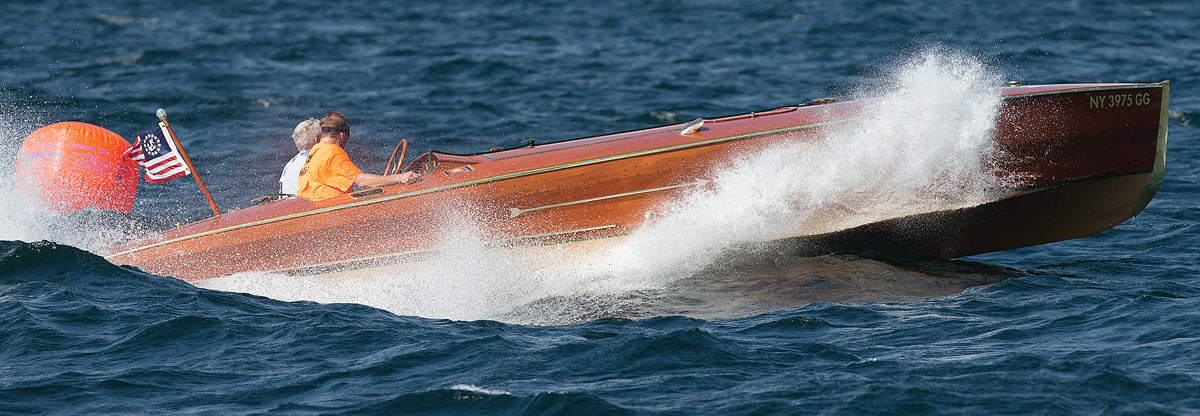
This 2012 replica of the legendary EL LAGARTO, which brought the Gold Cup to Lake George in 1933, was built by Fish Brothers Marine Service. She’s powered by a 454 big-block Chevy.
Last September, the 2015 Gold Cup Festival on Lake George celebrated the 80th anniversary of EL LAGARTO’s unprecedented three-year streak. Nearly three dozen boats attended, and about a third of them were original racing machines from the 1920s and ’30s. Among them was EL LAGARTO herself—not running, but on display at the nearby Tumblehome Boat Shop. BABY WATERCAR, a 1937 Dodge now in the collection of the Antique Boat Museum of Clayton, New York, sat on a trailer by the waterfront, allowing an unusually close look at the bottom and construction of an original Gold Cup–class boat. Others were modern reproductions, built with exacting attention to detail. Among these were two new GarWoods: BABY GAR V and LULU, the latter a modified version of an eponymous 16′ GarWood Speedster. Hacker’s EL LAGARTO had not one but two reproductions on the lake that weekend. Many of the boats, both antique and modern, carried the same vintage aircraft engines—mostly Packards and Hispano-Suizas—that defined the Gold Cup class, and the era, as firmly as the hulls themselves.

This replica of Gar Wood’s BABY GAR V was built in 1995—70 years after the original was launched—by Gar Wood Custom Boats.
The three-day event included dockside viewing, panel discussions on the finer points of hydroplane racing—both vintage and modern—and a narrated parade of boats. The highlight of the celebration, however, was a spectacular re-creation of a Gold Cup racing heat in which replica boats ripped around a roughly 2-mile course for more than an hour. Though a breezy Saturday afternoon produced less-than-ideal racing conditions, with whitecaps across the lake, it was a heart-quickening show. Often, only the bow of a boat was visible ahead of curtains of spray that obscured the driver and mechanic in their aft cockpit as the competitors crashed through one another’s wakes and skipped broadside around the turning marks.
The only thing missing was the squadron of biplanes carrying cameramen that show in black-and-white press footage of the original races. But Alison Langley was there, capturing the highlights for this article. As you can see from her photographs, this was a rare and spectacular weekend.
ETHYL RUTH IV
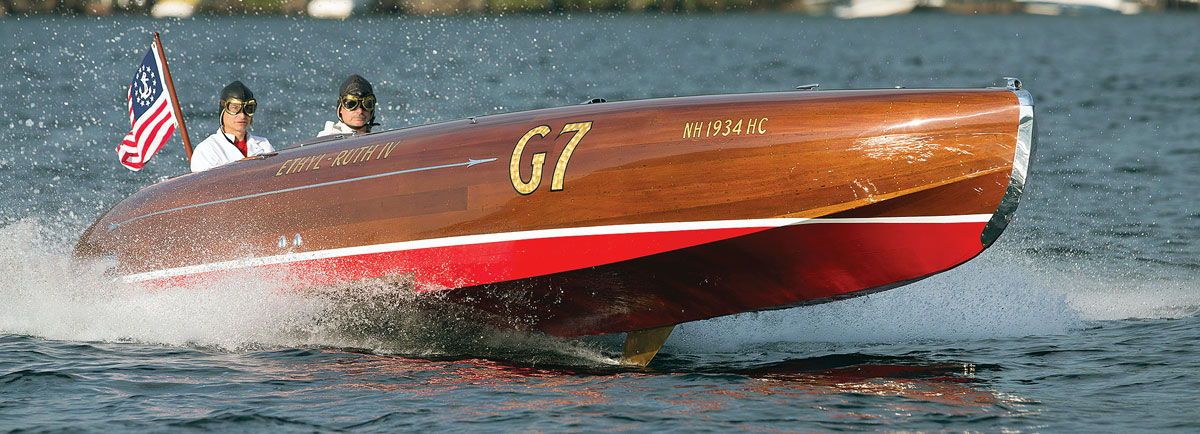
ETHYL RUTH IV
- Year built: 1934
- LOA: 27′
- Designer: John Hacker
- Current engine: 454-cu-in Chevy
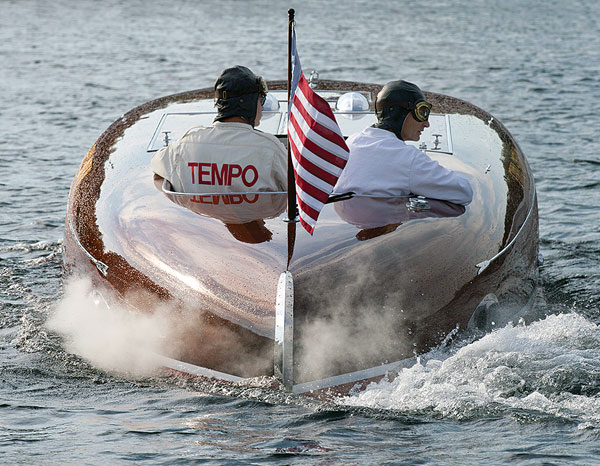
Initially, displacement hulls reaching only about 30 mph were the bread and butter of the Gold Cup. In the first decade and a half of racing, there were no limits on hull shape or engine displacement. But with rapidly increasing horsepower, a shifting of engine weight aft, and experimentation with hull shapes, planing hulls that could run 40–50 mph soon became the standard. But by the late teens, competition was beginning to grow stale; Gar Wood’s mechanical genius—and his deep pockets—so dominated the scene that in 1920 only three boats bothered to enter. Consequently, the organizers—the APBA—imposed restrictions that, in 1921, gave rise to what became known as the Gold Cup class.
The Gold Cup class was made up of so-called “gentleman’s runabouts,” which were suitable for recreation as well as racing. (Gold Cup boats were designated by a “G,” followed by an APBA-administered number. ETHYL RUTH’s G7 is visible here.) The class stayed active until World War II put racing on hold. When the series began again after the war, the rules were again modified to accommodate evolving technology, effectively ending the distinctive Gold Cup class and bringing back the unrestricted classes.
In early racing, the riding mechanic was as vital to success as the driver. He monitored the oil pressure, hand-pumped air into the fuel tanks to maintain consistent pressure, and acted as a second pair of eyes. Engine failure was routine in what amounted to an incredibly high-speed endurance test. It was not uncommon for all of the boats to find themselves simultaneously adrift mid-heat and mid-course while the mechanics, aided by their drivers, worked madly to restart stalled engines.
Though never a Gold Cup winner, ETHYL RUTH IV was the only boat at the festival, besides EL LAGARTO, to have participated in the 1935 race. ETHYL RUTH IV, BABY SKIPALONG (page 40), and IMP II (page 40), all original boats with vintage engines and antique hardware, belong to Lee and Penny Anderson of Nisswa, Minnesota. While the Andersons were unable to attend the festival themselves, they sent a crack team of mechanics and drivers to run their remarkable fleet.
MISS DETROIT III
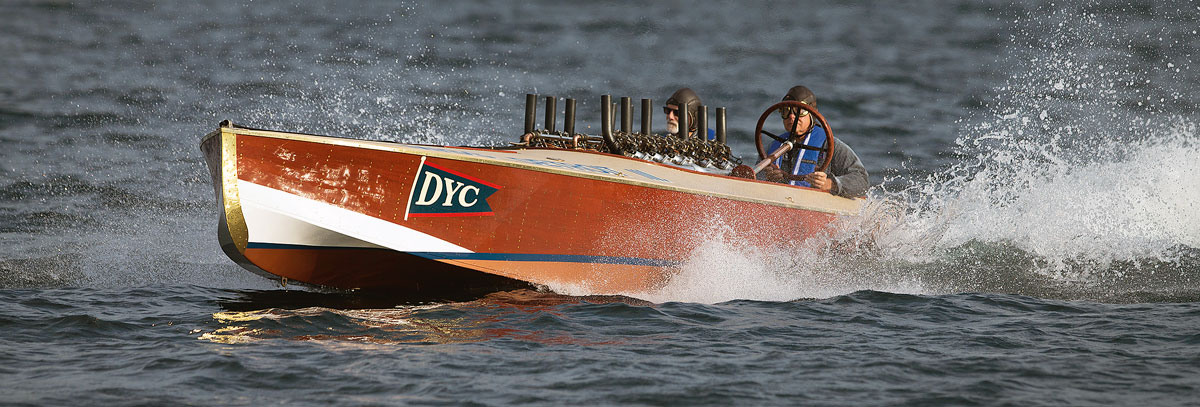
MISS DETROIT III
- Year built: 2005
- LOA: 20′
- Builder Mike Michaud
- Designers: Chris Smith, Gar Wood, and Nap Lisee
- Current engine: 1916 Curtiss-Smith V-12
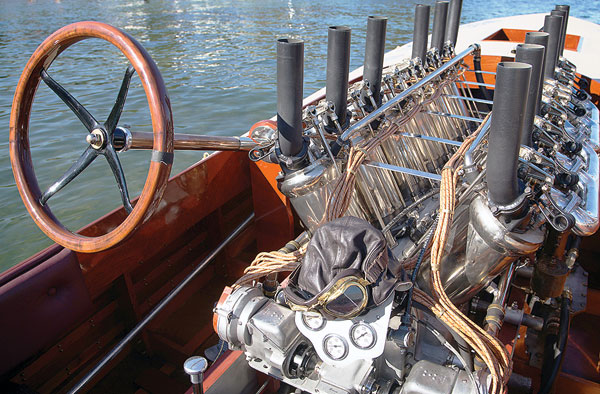
On the morning of the main event, MISS DETROIT III was among the first boats launched. With a small crowd watching from the dock, she was gently floated off her trailer. The driver and riding mechanic were both suited up in denim jumpsuits and leather racing caps and goggles. When they started the engine to warm it up, eyes widened with the rumble, and hands rose to muffle ears. MISS DETROIT III’s mechanic then shut down the engine, engaged the V-drive mechanism (a direct-drive; there’s no reduction gear), and restarted the now-warm engine. In a great puff of exhaust and shower of spray, she was gone, leaving only an enormous and rapidly mushrooming cloud of silt at the water’s edge.
Almost simultaneously, the marina attendant hurried out from the office, arms waving. “Don’t those boys know it’s a 5-mile-an-hour speed limit in here!?” Then someone said sheepishly: “Sorry, but she doesn’t idle at anything less than eight.” (To be fair: The boat can only be run with such “point and shoot” starts, and the event’s organizers had procured temporary reprieves from noise and speed limits for the day.)
MISS DETROIT III stands out even in this eye-catching fleet. She lacks the flashy aerodynamic above-water profile so common with the Gold Cup class, and instead has an ordinary sheer and a no-frills hard-chined look. Though none of the boats are much beamier than a rowboat, this one has a comparatively broad and unapologetic transom. Her oversized steering wheel appears to diminish her driver and mechanic to almost childlike proportions, and there’s no windshield, no dashboard, and a minimum of hardware. She never fails to draw a crowd. Then again, how could she not with that absolutely outrageous engine? Twelve stacks sprout directly from cylinders that collectively displace 1,650 cu in, their tops just aligning with her driver’s line of sight and heat-bending the air above them in photographs. The 1,200-lb engine occupies about a third of the boat’s 20′ length. The hull is a handsomely executed reproduction, but it’s the original engine that will knock the air out of your lungs. In looking her over, there is little doubt that the hull was designed to carry this particular engine.
The original MISS DETROIT III was a collaborative design by Chris Smith of Chris-Craft fame, Gar Wood, and Napoleon (“Nap”) Lisee, to create an envelope for the stunning V-12 engine designed by aeronautical engineer Glenn Curtiss and assembled by the Curtiss Aeroplane and Motor Company in 1916. This particular Curtiss-Smith engine is one of only two existing prototypes that were presented to the British Air Corps. The Corps declined to procure the production rights, perhaps due to the impending arrival of the lighter and more powerful Packard Liberty L-12s. Though unfortunate for Curtiss, it was a windfall for Gar Wood, who acquired one of the prototypes in 1917 and modified and raced it for a time, moving it through several different hulls.
MISS DETROIT III, driven by Wood, won the 1918 Gold Cup, and defended her title the following year. She and her Curtiss-Smith engine represent an earlier era of powerboat racing, and the boat is surely a showpiece and a crowd pleaser. If you’re in the right place at the right time after dark at a vintage powerboat gathering, you might be lucky enough to see the ghostly blue flames dance from the tops of the stacks as the V-12 roars in the night.
SCOTTY-TOO

SCOTTY-TOO
- Year built: 1929
- LOA: 26′
- Designer: John L. Hacker
- Current engine: 1,127-cu-in 300-hp V-8 Hispano-Suiza (1918)
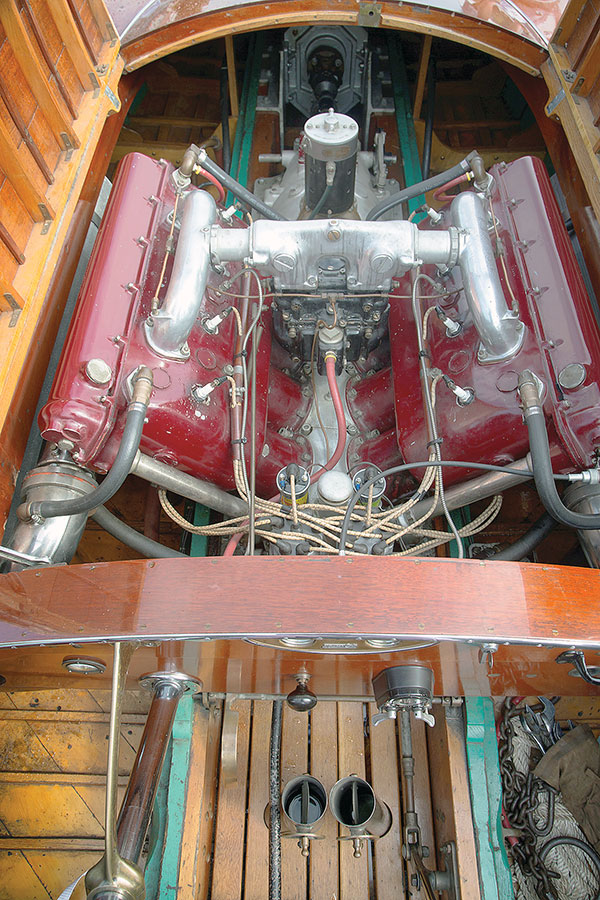
The APBA’s 1921 Gold Cup restrictions not only prohibited stepped and shingled bottoms, but also limited engine size to 625 cu in and required a waterline length of between 25′ and 40′. To earn a Gold Cup–class designation, boats were also required to have wet exhausts running through the stern. Gearboxes with forward, neutral, and reverse were mandated. The boats had to carry running lights and be able to seat two passengers in addition to the driver and mechanic. These rules were intended to bring back a more “gentlemanly” spirit to the competition. They aimed to break the “he-with-the-deepest-pockets-wins” trend. In theory, the rules were also meant to encourage use of the boats for activities besides racing. In effect, the restrictions stifled the competition, and were relaxed somewhat after a few years to allow, as noted in the case of IMP II (page 40), stepped bottoms. However, the waterline-length limits remained in place. So did the engine restriction, which gave rise to the classic Packard Gold Cup engine. Because these Packards were designed right up to the edge of the 625-cu-in limit, many boats from this period carried them, and a number of the festival’s entrants do, too.
A pre-restriction 1918, 300-hp Hispano-Suiza V8 of nearly twice the Gold Cup-class displacement limit was installed in SCOTTY-TOO during restoration in the 1980s. Despite her high power, this 1929, 26′, three-stepped, Hacker design is a modern embodiment of what the Gold Cup–class restrictions intended to promote within the racing community—that is, boats that were not only racing machines, but that could also be used for leisure.
Note the valves aft of the dash bulkhead: These are the tops of tubes—or “siphons”—that run from the steps on the boat’s bottom. When the valves in these tubes are opened, they decrease suction by ventilating the steps; when closed they increase suction, which can be helpful in turning.
SCOTTY-TOO currently belongs to Judy Larter, wife of the late Antique & Classic Boat Society (ACBS) founding member Ted Larter. The boat has now been in the Larter family for 45 years and three generations. Mark Mason, who was instrumental in the revival of the historic Gold Cup fleet, and expert builder Everett Smith, collaborated with Ted to restore SCOTTY-TOO. To this day, SCOTTY- TOO is still used for pleasure. She lives in a boathouse at Silver Bay on Lake George. On the morning of the race, Ted’s 15-year-old grandson Teddy rode in the mechanic’s position alongside his uncle Alan and helped pilot her the 10 miles to the festival.
BABY SKIPALONG

BABY SKIPALONG
- Year built: 1924
- LOA: 27′
- Builder: Henry B. Nevins
- Designer: Frederick K. Lord
- Current engine: Packard Gold Cup engine
Early Gold Cup races consisted of three, 30-mile heats around a roughly 5-mile course, for a grand total of 90 grueling miles. Teams constantly experimented with engines and hulls between races, and each was truly a one-off by the time it hit the starting line. Experimentation brought about great successes and wild failures. Speed records were routinely bettered, but there were also spectacular, and sometimes fatal, high-speed wrecks.
BABY SKIPALONG, built by Henry B. Nevins at City Island, New York, in 1924 is a rare success story following an initial failure in design. In the 1925 Gold Cup in Greenwich, Connecticut, this boat capsized before the starting gun was fired, and was unable to race that year. Stability and maneuverability were vital in a heat that required close rounding of marks at extraordinary speeds. It mattered little how fast the boat could go in a straightaway if it couldn’t corner or cross a competitor’s wake without careening out of control, barrel-rolling, or even pitch-poling. An unsteady hand on the wheel could have disastrous results. Gold Cup courses always ran counterclockwise, so the boats would turn to the left, counteracting the massive torque of their righthand propellers. If they turned in the same direction as did their 17″-diameter, 27″-pitch propellers, they stood a much greater probability of rolling.
After BABY SKIPALONG capsized, her hull was modified for greater stability by widening her planing surface. The change proved to be extremely effective, and in 1926 the boat—then named GREENWICH FOLLY in a wry nod to her embarrassing performance in 1925—beat all 14 other entrants. While she wasn’t consistently the fastest boat, she won because of her steady performance, proving herself a formidable and reliable distance runner. BABY SKIPALONG successfully defended the Cup the following year as well, in a rather high-casualty race that saw only two of the entrants finish all three heats.
At the dock, BABY SKIPALONG’s dashboard hardware, elegant wheel-mounted throttle and spark advance, and Nevins builder’s plate all gleam. One of her two fuel tanks is visible to the driver’s left, and we get a glimpse of her vintage fire extinguisher—a vital and frequently deployed accessory for any Gold Cup racer.
IMP II

IMP II
- Year built: 1930
- LOA: 28′
- Builder: Purdy
- Current engine: Packard Gold Cup engine
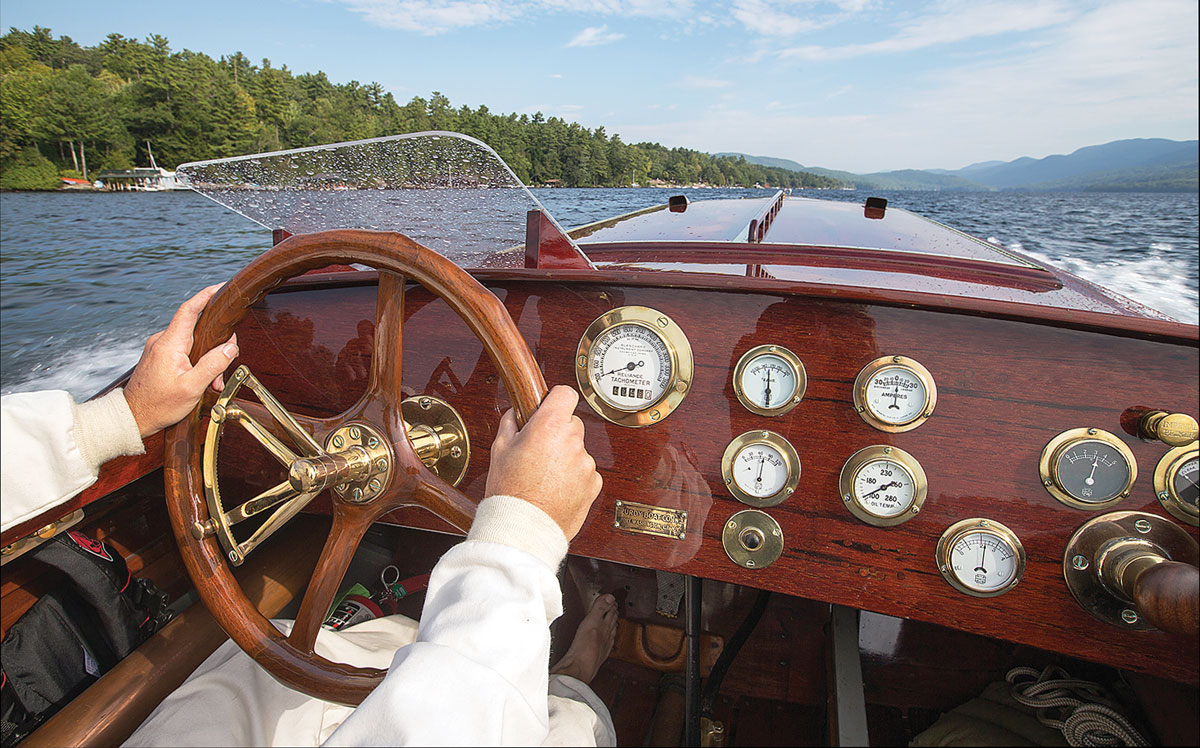
IMP II (G14) is a stunning example of an original hull and engine from the height of the Gold Cup–class era. Commissioned to replace the first IMP, which flipped and was totaled in the 1927 contest, this hydroplane was built in 1928 by the Purdy Boat Company on Long Island for Richard Hoyt, the chairman of Wright Aeronautical Company. Its bottom is stepped, meaning that in profile it looks like a shallow staircase; the result of this is reduced friction and thus higher speed. In 1921, steps and shingles (essentially applied “steps”) were outlawed, but this restriction was lifted in advance of the 1929 race in which IMP II debuted—and won.
IMP II’s stern illustrates the experimentation that went on during her era. As one vintage boat owner described it, “You could put a ram bow on one of these things, or have a completely open forward end filled with Adirondack chairs—it really doesn’t matter what’s going on up forward above the waterline…but the plan view and profile in the stern, those are vital.” The elegant arrangement of the wing-like “bustles” visible in IMP II’s stern effectively gives her a flat-bottomed, square-sterned hull, which makes a better planing surface than a narrow stern; it also reduces the hull’s tendency to “gallop” when planing. The torpedo-sterned above-waterline aesthetic was prevalent during this era. When I asked one professional builder about this lovely but seemingly superfluous shape, he shrugged and grinned: “Aerodynamics?” Another owner added that it also allowed the designers to experiment with the distance between the functional stern and the propeller and rudder. This distance has an impact on the angle of attack, which in turn affects how the boat runs and handles.
DIXIE BABY
DIXIE BABY
- Year built: 1921
- LOA: 24′
- Builder: Ventnor
- Current engine: Hispano-Suiza WWI aircraft engine
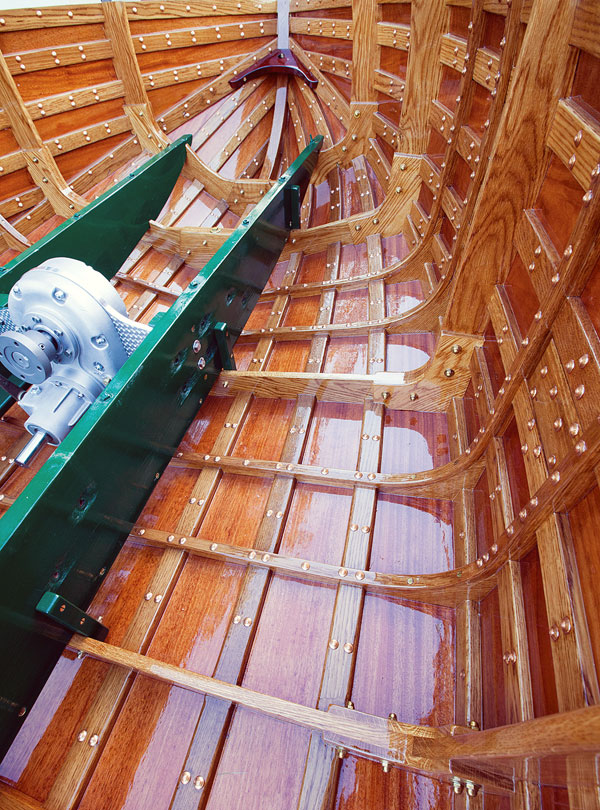
DIXIE BABY, a 1921, 24′ Ventnor hydroplane, is not a Gold Cup boat; rather, she was designed and built to the rules of the Mississippi Valley Power Boating Association (MVPBA), whose racers were working-class boats, characterized by their down-home feel. The MVPBA didn’t limit power, and the engines were often completely exposed so the crews could tell if a fire had started before flames came shooting out from under the dash—as tended to happen with the decked-over Gold Cup boats. But being of the same vintage as Gold Cup boats of the pre-restriction era (before 1921, that is), she shows how early Gold-Cuppers were built, since Gold Cup and MVPBA boats of this time were effectively identical. In fact, DIXIE BABY and MISS DETROIT II are quite similar to each other.
DIXIE BABY is currently being rebuilt by Peter Breen of Rockwood, Ontario. Seeing the boat at mid-restoration provides a rare look at the structure of a high-powered vintage raceboat. The stringers run the entire length of the hull, the frame spacing is unusually close, and there’s an abundance of fastenings—illustrating that the primary function of the hull was to keep an engine on top of the water instead of under it and to not shake to pieces while running. At the same time, light weight was prized: Almost all bottoms were double-planked, with inner planking laid on the diagonal (though not in this boat), outer planking laid fore-and-aft, and a layer of bedded canvas between them. It was a delicate balance between weight and strength: In some boats, a surprising number of struts and sisters support broken frames.
JUNO
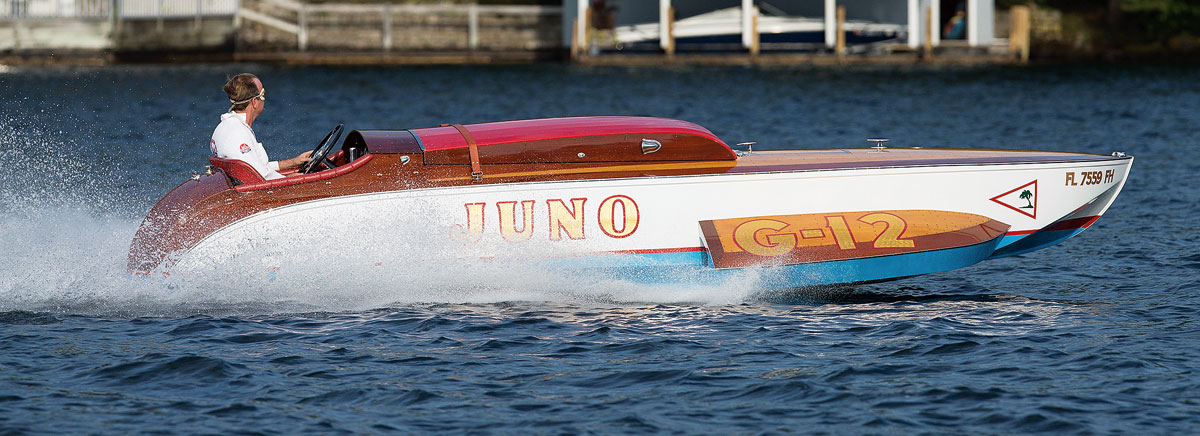
JUNO
- Year built: 1931
- LOA: 20′
- Designer/builder: Ventnor
- Current engine: Packard 621-M
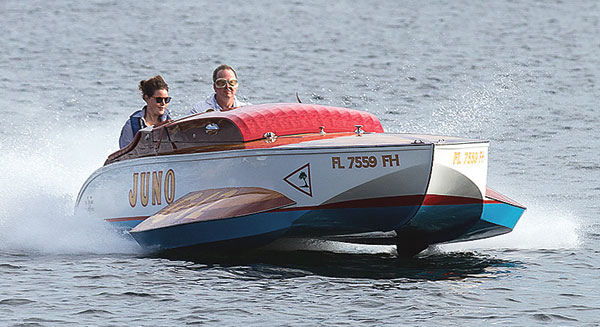
The 1937 Ventnor-built and Gold Cup Packard-powered JUNO is the other notable festival outlier after MISS DETROIT III. Where MISS DETROIT exemplifies an earlier stage in powerboat experimentation, JUNO stands for the beginning of a new era: that of the three-point hydroplane. The design, first commissioned by the Chinese navy as a suicide hull, could deliver a 500-lb payload at extraordinarily high speeds. Legend has it that Ventnor experimented with sponsons attached unusually far forward in order to increase buoyancy and stability despite their effect on trim. But the U.S. government blocked the export of the type after an initial order of a dozen or so hulls was shipped. JUNO, a prototype, was introduced to the racing scene by Jack Rutherford. In 1937, she beat EL LAGARTO’s speed record by a whopping 12 mph, clocking 84 mph in a timed trial.
JUNO’s hull is a total departure from the rest of the Gold Cup Festival fleet. Her cherry red canvas-over-battens hatch cover, delicate snubnosed bow, tucked-in stern, and the extended wingspan of her forward-set sponsons combine to give her the look of an oversized June bug or a wind-up race car. But when you see her flying at you head-on, you realize she’s really a shark—routinely cruising at speeds of 75 mph. Her sponsons nearly lift her entire hull free from the water when she gets up on plane, and rails running lengthwise along her chines trap air and create lift. Despite feeling like you’re strapped to a 20′ skipping stone that’s been thrown by a professional pitcher, it’s actually not as rough a ride as you might expect: Due to the sponsons and rails, the boat feels remarkably stable, and the ride is softened by the cushion of air trapped beneath the hull. It’s much less comfortable when idling into the waves, when the sponsons will treat you to a lovely continuous cold shower. All of these boats are happiest running when planing; at anything less, you get the sense that they’re just waiting to take off.
Today, JUNO divides her time between Florida and Clayton, New York, lovingly cared for by longtime owner and Gold Cup enthusiast Peter Kreissle. 
Evelyn Ansel grew up in Mystic, Connecticut, and has studied, sailed in, and simply enjoyed boats from Venice to Stockholm and beyond. When not on the water, she spends most of her time in museums and conservation labs. She writes regularly for WoodenBoat.
